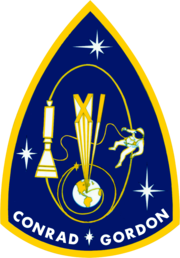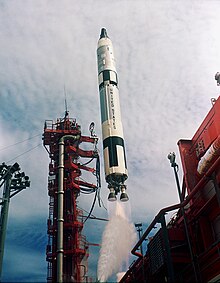Gemini 11
 Gemini XI conducting a tether experiment using the Agena Target Vehicle | ||
| Mission type | ||
|---|---|---|
| Operator | NASA | |
| COSPAR ID | 1966-081A | |
| SATCAT no. | 2415 | |
| Mission duration | 2 days 23 hours 17 minutes 9 seconds | |
| Orbits completed | 44 | |
| Spacecraft properties | ||
| Spacecraft | McDonnell | |
| Launch mass | 3,798 kilograms (8,374 lb) | |
| Landing mass | 1,920 kilograms (4,230 lb) | |
| Crew | ||
| Crew size | 2 | |
| Members |
| |
| Start of mission | ||
| Launch date | September 12, 1966, 14:42:26 UTC | |
| Rocket | LC-19 | |
| End of mission | ||
| Recovered by | USS Guam | |
| Landing date | September 15, 1966, 13:59:35 UTC | |
| Landing site | 24°15′N 70°0′W / 24.250°N 70.000°W | |
| Orbital parameters | ||
| Reference system | Geocentric | |
| Regime | Low Earth orbit | |
| Perigee altitude | 298 kilometers (161 nmi) | |
| Apogee altitude | 1,368 kilometers (739 nmi) | |
| Inclination | 28.8 degrees | |
| Period | 101.57 minutes | |
| Epoch | September 14, 1966[1] | |
| Docking with GATV-5006 | ||
| Docking date | September 12, 1966, 16:16:00 UTC | |
| Undocking date | September 14, 1966, 16:55:00 UTC | |
| Time docked | 2 days 39 minutes | |

 Gordon (left) and Conrad | ||
Gemini 11 (officially Gemini XI)
Crew
| Position | Astronaut | |
|---|---|---|
| Command Pilot | Charles "Pete" Conrad Jr. Second spaceflight | |
| Pilot | Richard F. Gordon Jr. First spaceflight | |
Backup crew
| Position | Astronaut | |
|---|---|---|
| Command Pilot | Neil A. Armstrong | |
| Pilot | William A. Anders | |
Support crew
- Clifton C. Williams Jr. (Cape CAPCOM)
- John W. Young (Houston CAPCOM)
- Alan L. Bean(Houston CAPCOM)
Mission parameters
- Mass: 8,374 pounds (3,798 kg)
Highest orbit (followed twice):
- Perigee: 156.4 nautical miles (289.7 km)
- Apogee: 739.2 nautical miles (1,369.0 km)[3]
- Inclination: 28.85°
- Period: 101.52 min
Docking
- Docked: September 12, 1966, 16:16:00 UTC
- Undocked: September 14, 1966, 16:55:00 UTC
Space walk
- Gordon – EVA 1
- Start: September 13, 1966, 14:44:00 UTC
- End: September 13, 1966, 15:17:00 UTC
- Duration: 0 hours 33 minutes
- Gordon – EVA 2 (stand up)
- Start: September 14, 1966, 12:49:00 UTC
- End: September 14, 1966, 14:57:00 UTC
- Duration: 2 hours 08 minutes
Objectives
- Perform a direct-ascent Command/Service Moduleafter a lunar landing.
- Use the Agena rocket engine to put the combined craft in a high-apogeeelliptical orbit.
- Perform two extra-vehicular activities.
- Demonstrate passive attitude stabilization of the two spacecraft connected by a tether and create artificial gravity by spinning the combined craft.[4]
- Perform miscellaneous scientific experiments.
- Perform a computer-controlled atmospheric reentryto a precision splashdown point.


| Gemini 11 | Agena info |
|---|---|
| Agena | GATV-5006 |
| NSSDC ID: | 1966-080A |
| Mass | 7,000 pounds (3,200 kg) |
| Launch site | LC-14 |
| Launch date | September 12, 1966 |
| Launch time | 13:05:01 UTC |
| 1st perigee | 156.4 nautical miles (289.7 km) |
| 1st apogee | 165.8 nautical miles (307.1 km) |
| Period | 90.56 min |
| Inclination | 28.84 deg |
| Reentered | December 30, 1966 |
Flight

The direct-ascent rendezvous and docking with the Agena vehicle was achieved approximately 94 minutes after lift-off, depending on the on-board computer and radar equipment with only minimal assistance from ground support.[4]
Gemini 11 used the rocket on its Agena target vehicle to raise its apogee to 853 miles (1,373 km), the highest Earth orbit ever reached by a crewed spacecraft.[5] The perigee was 179 miles (288 km), and maximum velocity (at perigee) was 17,967 miles per hour (28,915 km/h).[4] The apogee record stands as of October 2022, even though men have achieved greater distances from Earth by flying to the Moon in the Apollo program.[6] The maximum operational altitude of the Space Shuttle was much lower, at 386 miles (621 km) for the STS-31 flight in 1990. The September 2021 SpaceX flight of Inspiration4, while having an apogee higher than most Space Shuttle flights, only reached 585 kilometres (364 mi).[7]
The crew docked and undocked four times and still had sufficient Gemini maneuvering fuel for an unplanned fifth rendezvous. They did not remain in the high orbit, but changed it back to a near-circular one at 184 miles (296 km).[4]
Gordon's first EVA, planned to last for two hours, involved fastening a 100-foot (30 m) tether, stored in the Agena's docking collar, to the Gemini's docking bar for the passive stabilization experiment. Gordon achieved this, but as with previous Gemini EVAs, trying to do work for an extended period proved more fatiguing than in ground simulation, and the EVA had to be terminated after only half an hour.
The passive stabilization experiment proved to be a bit troublesome. Conrad and Gordon separated the craft in a nose-down (i.e., Agena-down) position, but found that the tether would not be kept taut simply by the Earth's gravity gradient, as expected. However, they were able to generate a small amount of artificial gravity, about 0.00015 g, by firing their side thrusters to slowly rotate the combined craft like a slow-motion pair of bolas.[4]
Gordon successfully performed a second EVA standing up with his head and shoulders out of the hatch to photograph the Earth, clouds, and stars. This was not tiring and lasted more than two hours.[4]
Scientific experiments
The 12 scientific experiments were:[8]
- Mass Determination: To test a technique and accuracy of a direct-contact method of determining the mass of an orbiting object, in this case the Agena Target Vehicle.
- Night Image Intensification: To test the usefulness and performance of a low-light-level television system as a supplement to unaided vision in observing surface features primarily when such features are in darkness and spacecraft pilots are not dark-adapted.
- Power Tool Evaluation: To evaluate man's capability to perform work tasks in space, including the comparison of ability to work tethered and untethered, and to evaluate the performance of the minimum-reaction power tool.
- Radiation and Zero G Effects on Blood and Neurospora: To determine whether weightlessness enhances the effects of radiation on human white blood cells and Neurospora crassa fungi.[9]
- Synoptic Terrain Photography: To obtain high-quality photographs for research in geology, geophysics, geography, oceanography, and related fields.
- Synoptic Weather Photography: To obtain selective high-quality photographs of clouds to study the fine structure of the Earth's weather system.
- Nuclear Emulsion: To study the cosmic radiation incident on the Earth's atmosphere, to obtain detailed chemical composition of the heavy primary nuclei, and to search for rare particles.
- Airglow Horizon Photography: To measure by direct photography the heights at which atomic oxygen and sodium layers occur in the upper atmosphere.
- Ultraviolet Astronomical Camera: To test the techniques of ultraviolet photography under vacuum conditions and to obtain ultraviolet radiation observations of stars in wavelength region of 2,000 to 4,000 angstroms by spectral means.
- Ion Wake Measurement: To determine and measure the ion and electron wake structure and perturbation of the ambient medium produced by an orbiting vehicle, and to study the changes in the ion flux and wake caused by thruster firings.
- Earth-Moon Libration Region Photography: To investigate the regions of the L4 and L5 libration pointsof the Earth–Moon system to determine the possible existence of clouds of particulate matter orbiting the Earth in these regions.
- Dim-Light Photography and Orthicon: To obtain photographs of various faint and diffuse astronomical phenomena.
Reentry
The mission ended with the first totally automatic, computer-controlled
Astronaut recovery was done by Navy Helicopter Squadron HS-3.
The Gemini 11 mission was supported by 9,054 United States Department of Defense personnel, 73 aircraft, and 13 ships.[10]
Insignia
Since Conrad and Gordon were both members of the
Potential lunar missions
Gemini 11's record altitude was ultimately the result of an internal race to
Pete Conrad liked these ideas and together with McDonnell corporations strongly advocated his Gemini 11 to be circumlunar. Discretely called 'Gemini - Large Earth Orbit', the plan would use a Titan IIIC-launched Transtage. The Gemini 11 crew would be launched with the Titan II GLV as they did in reality, and would dock with the Transtage, which would then boost them to translunar velocity. Conrad managed to stir Congressional interest, but NASA administrator James Webb informed them that any extra funds Congress cared to appropriate for such a project would be better spent accelerating the Apollo program. After further internal struggles, Conrad finally got NASA approval for the Agena on his Gemini 11 flight to boost him onto two record highly elliptical 1,370 km orbits. This high flight was the only remnant of lunar Gemini.[11]
Spacecraft location
The spacecraft is on display at the
See also
- Agena Target Vehicle
- Extra-vehicular activity
- List of spacewalks
- Splashdown
- Space exploration
- U.S. space exploration history on U.S. stamps
- Space capsule
- Space suit
Notes
![]() This article incorporates public domain material from websites or documents of the
This article incorporates public domain material from websites or documents of the
- ^ McDowell, Jonathan. "SATCAT". Jonathan's Space Pages. Retrieved March 23, 2014.
- ^ Hacker, Barton C.; Grimwood, James M. (September 1974). "Chapter 11 Pillars of Confidence". On the Shoulders of Titans: A History of Project Gemini. NASA History Series. Vol. SP-4203. NASA. p. 239. Archived from the original on 2010-01-13. Retrieved 2013-09-26. With Gemini IV, NASA changed to Roman numerals for Gemini mission designations.
- ^ Dumoulin, Jim (August 25, 2000), NASA Project Gemini-XI, archived from the original on February 1, 2012, retrieved April 12, 2010
- ^ a b c d e f g
Gatland, Kenneth (1976), Manned Spacecraft, Second Revision, New York, NY, USA: MacMillan Publishing Co., Inc, pp. 180–182, ISBN 0-02-542820-9
- ^ Agle, D. C. (September 1998). "Flying the Gusmobile". Air & Space.
- Lunar Module was not ready in time for the D mission planned for December 1968, which was a low Earth orbit test (see List of Apollo missions). Therefore, the E mission was cancelled and replaced with the D mission in March, and Gemini 11's apogee record stands.
- ^ @spacex (September 16, 2021). "Second phasing burn complete. Dragon and the @inspiration4x crew have reached a circular orbit of 585km – a new Dragon altitude record" (Tweet) – via Twitter.
- ^ "NASA Gemini 11 Press Kit" (PDF). Archived from the original (PDF) on 21 July 2011. Retrieved 2011-02-10.
- ^ Bender, M. A.; et al. (September 1971). "Radiation and zero-gravity effects on human leukocytes and Neurospora crassa". Nasa. Manned Spacecraft Center the Gemini Program Biomed. Sci. Expt. Sum. NASA. Archived from the original on 22 January 2017. Retrieved 22 January 2017.
- ^ Hacker, Barton C.; Grimwood, James M. (1977). "Appendix G DoD Support". On the Shoulders of Titans - The History of Project Gemini (PDF). p. 596. Retrieved December 18, 2022.
- ^ "Gemini: Lunar Gemini". Archived from the original on July 13, 2016.
External links
- NASA Gemini 11 press kit - Sep 2, 1966
- The short film Gemini XI is available for free viewing and download at the Internet Archive.
- Spaceflight Mission Patches
- NASA Space Science Data Coordinated Archive
- U.S. Space Objects Registry



